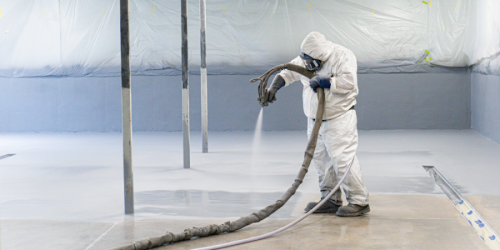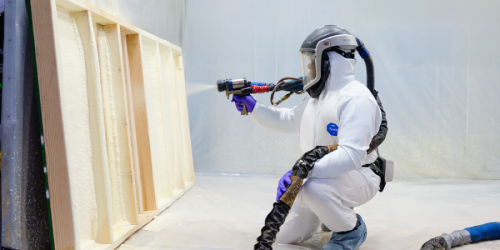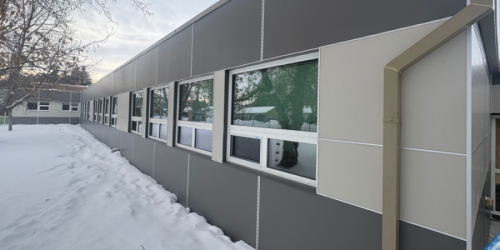Q&A Forums
Stupid Questions. Post New Topic | Post Reply
| Author | Comments |
|---|---|
|
Posted: Apr 30, 2006 07:29 PM
|
Stupid Questions.
A new home of 2000 square feet area, has 9 feet ceiling height inside from floor to drywall ceiling. Timberframe 2x4 construction with Tyvek wrapping and single layer brick veneer. I reckon total wall are to be foamed is around 1700 square feet after deducting windows but not timber framing. Local code requires in-wall insulation of 1.8 R value and 2.5 R in the ceiling. Common insulation would be fiberglass bats of 3" with R1.8 in the walls and R 2.5 batts layed on top side of drywall ceiling. No requirement for filling any gaps around windows or pipes etc. Obviously even if the batts were properly "friction fitted" ( lol ) the R would not be very good. This is a typical house in my area. If foam has an R of 4 per inch wouldnt it be far better than what they are doing now, even if you only put one inch of foam in. Would 1 inch of foam in walls and then batts on the ceiling drywall or even cellulose be a better form of insulation? Houses here in New Zealand suffer from condensation and not many have hvac systems although reverse cycle air con is gaining in popularity. Lots of homes have open fire places and most new homes use either small gas heaters or built in gas fire places. In my area temps range from 8 degrees Celcius to 28 C. I have read alot about foam. Would increasing the R by installing foam create more of a condensation problem? What if you went to 2 inches of foam for R8? Would you have to install some mechanical ventilation? There is info here in NZ that says buildings must "breathe", so would 2 inches of foam cause problems? Typical homes here dont have the big custom designed roofs so would it be feasible to spray the underside of the concrete roof tiles with foam as well as around the tops of exterior walls to complete the building envelope and thereby do away with the ceiling batts? Say there was 1700 sft in the walls and say a roof area 3000 sft (2000 plus 1000 to allow for the roof pitch) plus some extra to seal the lid how much faom would you use to do the job? For one inch and 2 inch providing the extra inch is needed. From reading this board I reckon a 2 man crew could do the walls in under 4 hours including clean up,is that about right? Just trying to work out how much it would cost to compare with what traditionaly done here. I know there will be massive energysavings with foam so am trying to work out some figures to present to local builders. Also do you know of any web sites that can explain the technical side of foam and condensation , conditioned spaces, etc so I dont have to ask too many more stupid questions as I know all you guys are working hard and time is money! Cheers Guys and thanks Steve. |
|
Mike Glace
Posted: May 07, 2006 12:13 AM
|
u have been doing a good amount of research yes 1 inch of foam is better than glass. the average open cell is about r-4 per inch, also there is a closed cell foam and at one inch the r value is about 7 or so also closed cell does not let any moisture through at all. Where im located ther trying to change the codes about houses being able to breath so we could spray and seal every thing,u would have to have an air ciculater or somthing, the job ur talking about wouldn;t take me and my partner long at all concidering we been doing 10000 sq ft jobs in about 2 days. i cant answer all ur questions cause still after only one year we are still learning and we got so busy so fast that somethings we tought our self..If i were u id research the closed cell foam it works so great, at 6 inches its like r 42 and a moisture barrier, no fiberglass can compeat with that... Do a google search and type spray foam and u should find plenty of web sites about it.. |
|
Posted: May 14, 2006 07:00 AM
|
most closed cells are vapor permiable at 1" it typically takes a 1 1/2" to 2" closed cell build to obtain a vapor retarder.... |
|
Ryan Rhoads
Posted: May 14, 2006 04:39 PM
|
First of all if you have high condensation problems down there than foam will be better than anything else. I would highly recomend using 2 lb. foam becuase it can actualy seal out water and eliminate condensation. I have everything from foundations to storage containers to eliminate condensation. When you talk condensation you are really talking dew point. By installing foam insulation you are doing two things. A you are moving the dew point to the outside of the home by fully adhering to the substrate and not allowing air (laden with moisture) to reach the colder substrate and two you are preventing that substate to transfer the moisture to the inside of the building. Here we have potato cellars, to store potato's you utilize basically huge swamp coolers to blow cold moisture laden air up through the potato's. This moisture laden air would make any loose insulation worthless becuase it would trap that moisture and thus reduce it's R-value to nothing. In the summer to cool off what do you do you sweat, sweat evaporates thus cooling you off. So when insulation is wet and holding moisture in it, it allows that moisture to evaporate and cools off the building, after all water is a pretty good carrier of heat. 2lb foam does not absorb moisture and does not allow air currents to pass through it so it truly insulate under the most adverse conditions like our potato wharehouses. Home's only need to breath to provide the inhabitants with oxygen and to dry the house out. By letting a home breath naturaly you are allowing more moisture, heat, cold and allergens into you home. By mechanical ventilation you can dehumidify the air, filter the air, and preheat or cool the air prior to it coming into your home. 2 in. of 2 lb. foam has a permiability of less than 1 perm. therefore it is a moisture barrier and you don't need the tyvek, wich is a bandaid for fiberglass to reduce air and moisture infiltration, and you don't need a vapor barrier. I hope this helps. Another thing if you are in a high moisture area I would insulate the bottom of the roof deck with a 1/2 lb. foam. This will a help the roofing material last longer by not creating a greenhouse effect in the attic and to will prevent in condensation on the bottom of the roof deck at night that will drip onto the loose insulation below. I hope this helps. If you really want to understand dew point, becuase that is what condensation really is, go find you a farmer and preferably someone who raises hay. Suprisingly enough they understand dew points more than moist people. If you have any more questions just post them. If you have a question about pricing email me at bendriftin@excite.com. I don't want to devulge what we pay for foam just becuase the public has access to this too and they don't understand that to stay in buisness you have to make a profit, also that you have to have money to make it throught the bad times not just the good ones. I shouldn't say everyone is that way but there are people like my dad that don't think you should make a profit at his expense, but will make damn sure they make one at yours. |
|
Posted: May 15, 2006 07:26 AM
|
ben-d...great post! but..tyvek is not a vapor barrier membrane, nor has it ever been designed to be used as one...(or all homes would have a vapor barrier on the cold side of the wall here in our cold climate zone,and this is not good...) it is an air barrier membrane... i agree with your priceing comments,,,people want you to do professional work with professional equipment and professional help in a timely professional fashion,,,for $.50 a square foot....or $5.00 and hour... f'em...feed em fish |
|
Posted: May 15, 2006 05:46 PM
|
Thanks Guys, you have both given me lots to think about. I have been working with a foam supplier here and it turns out that they have a large range of approved foams here already, which is great because I was worried about getting local council approval. I now know there are only 2 mobile rigs in the country so the market is fairly open here. marketing will be my big hurdle. |
|
Posted: May 15, 2006 06:02 PM
|
good deal stevo! sounds like a great market area! remember: early to bed,,, early to rise.... work like hell.... and advertise.... good luck mate! |
|
Ryan Rhoads
Posted: May 16, 2006 08:51 PM
|
Stevo: If you want to understand how water vapor, vapor drive and condensation work than I would highly recommend you check out this site, I just found it and it is very interesting. www.buildingscience.com/resources/walls/default. htm |





























